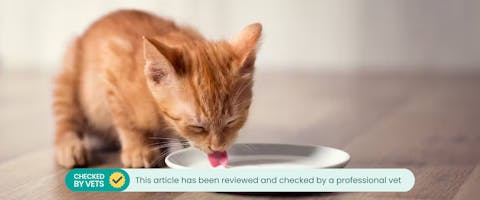Updated 10/05/2023
Can cats drink milk? Maybe it’s a question you didn’t expect to be asking - cute portraits of our feline friends lapping at a saucer of the so-called ‘good stuff’ is all over our favorite tv shows and films, after all. It turns out that milk (especially cow’s) is pretty bad for our feline friends. In fact, most cats are lactose intolerant.
Trending posts
Purr-use some of the top blogs our members have been loving this month- Top male dog names for your new furry friendGot a new furry family member in your pack? Check…

- Top female dog names for your new fluffy palWelcoming a new pooch into your family? Explore…

- 250+ gray cat names your silver feline will loveRecently welcomed a fluffy gray bundle of joy into…

- What are normal pet sitting rates?Discover the average pet sitting rates for animals…

- Unique dog names to stand out from the packDare to be different with our list of the best…

Is milk poisonous to cats?
There is a difference between ingesting a poisonous substance and having something you’re intolerant of, but milk isn’t safe for most cats. So, can cats have milk? The short answer is no, do not feed your cat milk. It might upset their stomach, no matter how much your furry friend purrs as you place the saucer down!
So is milk safe for cats? Nope, as most cats are lactose intolerant. This means they don’t house the enzyme, lactase, that’s needed for digesting lactose, the sugar which milk contains. The result of drinking milk? Your poor moggy will have an upset stomach.
They’ll experience diarrhea, stomach pains and vomiting - the same reactions that a lactose-intolerant human would have. And even though not all cats are intolerant to milk, it’s not worth the risk in our books. Our feline friends deserve to live their best, fence-hopping lives, right?
What kind of milk can cats drink?
Can cats drink cow’s milk? This one’s a straight up no - full of fat and of course lactose, your cat will not only gain weight, but they’re highly likely to experience a nasty reaction to it. You might be wondering whether you can simply feed your cat lactose-free, low-lactose or special pet milk (found in pet shops). Well the answer isn’t strictly no, but they may still have a reaction (to low-lactose milk), and it’s still full of fat. The solution? Look after your kitty’s waistline and give them water instead.
And while simple H2O is all your furry companion needs (plus a well-rounded solid diet, of course), we understand that you might want to give them a treat on special occasions. In this case, it’s fine to give small amounts of a pet milk if your cat tolerates it well. Just don’t make a habit of it!
The long and short of it is - cats should only really be drinking their mother’s milk when kittens, and move onto water once weaned. The only instance where your kitty may need milk regularly is if they’re being hand-reared. Under these circumstances, you’ll need to find specific kitten milk which they’ll need to be weaned from so that a healthy adult diet of water and solid food can be enjoyed in later years.
Why is milk bad for cats?
Along with their lactose intolerance, milk is pretty much like junk food for cats! Why? Well it’s full of fat, too much for our feline friends. It explains why they like the taste so much, but the weight gain, discomfort, health risks and intolerant reactions just aren’t worth it.
What to do if your cat drinks milk
If your cat has a reaction to milk (such as vomiting, diarrhea and seems to be in pain), these symptoms should go away by themselves within 24-48 hours. If they persist, make an appointment with your vet as soon as possible.
Meet our veterinary expert, Lizzie
This article has been checked by veterinarian Lizzie Youens BSc (Hons) BVSc MRCVS. Lizzie graduated from the University of Bristol in 2011, and has been working in first opinion companion animal practice. She has worked in a variety of clinics across the UK, from large hospitals to small branch practices. She enjoys doing a mixture of medicine, surgery and emergency work. Lizzie currently works in a small rural practice where she enjoys working in a close-knit community.

